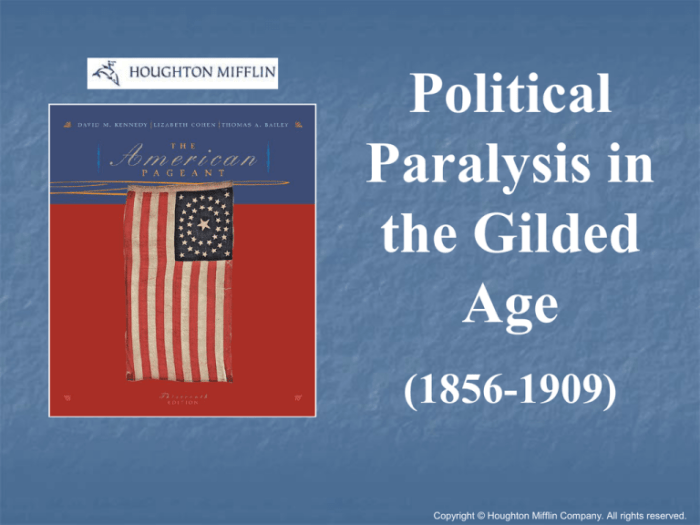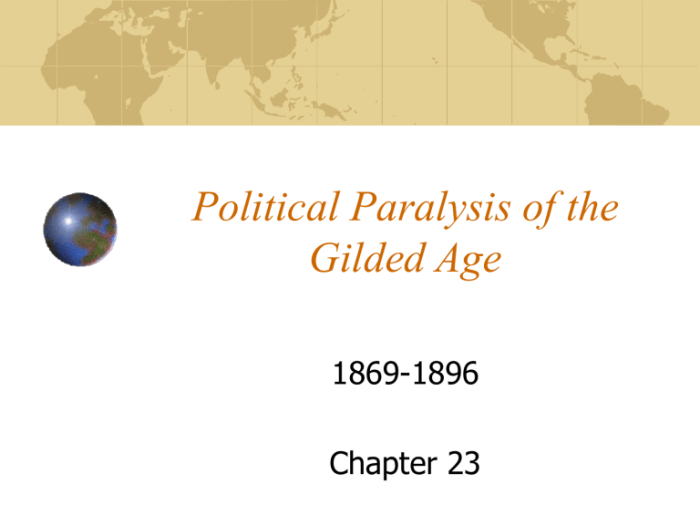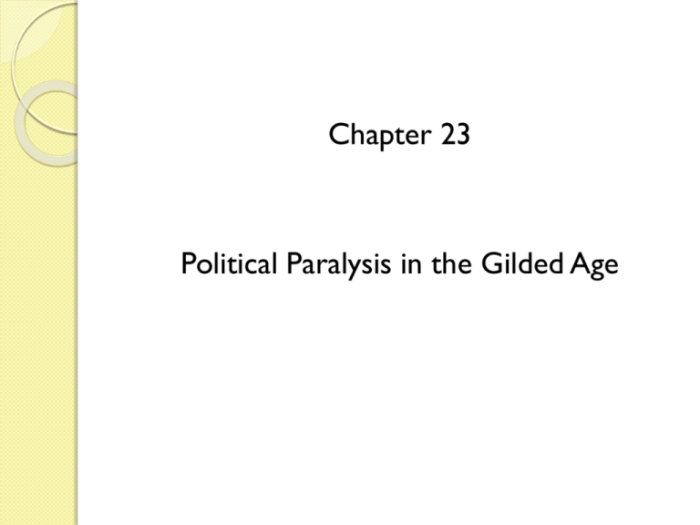Political paralysis in the gilded age – Political paralysis gripped the United States during the Gilded Age, a period marked by rampant corruption, social inequality, and economic turmoil. This comprehensive analysis delves into the intricate web of factors that contributed to this political impasse, exploring its profound impact on policymaking and the nation’s political landscape.
Gilded Age Political System: Political Paralysis In The Gilded Age

The political system during the Gilded Age was characterized by a decentralized and fragmented structure. The federal government had limited power, and states and local governments exercised significant autonomy. This decentralized system made it difficult to build consensus and enact legislation, contributing to political paralysis.
Political Parties
- Democratic Party:Represented the interests of the working class, farmers, and immigrants. Supported free silver, tariffs, and labor unions.
- Republican Party:Represented the interests of big business, wealthy elites, and industrialists. Supported gold standard, protective tariffs, and limited government intervention.
Corruption and Patronage
- Political Machines:Urban political organizations that controlled elections through patronage, vote buying, and intimidation.
- Bossism:Rule by powerful political bosses who controlled patronage jobs and political favors.
- Lobbying:Corporations and special interests exerted undue influence on politicians through bribery and other forms of corruption.
Economic Factors
Economic inequality was a major factor in fostering political paralysis during the Gilded Age. The concentration of wealth and power in the hands of a few industrialists and corporations led to a growing gap between the rich and the poor.
Role of Economic Inequality
- Wealthy elites had a disproportionate influence on politics, shaping policies that benefited their interests.
- Economic insecurity and labor unrest among the working class created social tensions and made it difficult to build consensus.
Social Divisions

The Gilded Age was marked by significant social divisions that contributed to political polarization and gridlock.
Major Social Divisions
- Urban-Rural Divide:Urban areas were growing rapidly, while rural areas were declining. This led to different economic and social interests.
- Class Divisions:The concentration of wealth in the hands of a few created a growing gap between the rich and the poor, leading to social unrest and class conflict.
- Immigrant Communities:Immigrants faced discrimination and prejudice, which created social tensions and made it difficult to build political coalitions.
Impact on Policymaking

Political paralysis during the Gilded Age had a significant impact on policymaking. Key issues were left unresolved, and legislation was often blocked or delayed due to political gridlock.
Specific Policy Areas, Political paralysis in the gilded age
- Tariff Policy:Protectionists and free traders were deeply divided, leading to years of gridlock over tariff rates.
- Monetary Policy:The debate over the gold standard versus silver standard divided the country and prevented the passage of meaningful monetary reform.
- Labor Policy:Efforts to regulate child labor and improve working conditions were blocked by corporate interests.
Long-Term Consequences
The political paralysis of the Gilded Age had long-term consequences for American politics and society.
Consequences
- Erosion of Public Trust:Political corruption and gridlock undermined public trust in government.
- Rise of Populism:Political paralysis led to the rise of populist movements that promised to address the concerns of the working class and the poor.
- Strengthening of Special Interests:The inability of the government to regulate corporations and protect the interests of the public led to the strengthening of special interests.
FAQs
What were the major political parties during the Gilded Age?
The two major political parties were the Republican Party and the Democratic Party.
How did economic inequality contribute to political paralysis?
Economic inequality led to a concentration of wealth and power in the hands of a few individuals, who used their influence to shape political decision-making in their favor.
What were some of the consequences of political paralysis during the Gilded Age?
Political paralysis resulted in gridlock and inaction on important issues, such as economic regulation, labor rights, and social welfare.